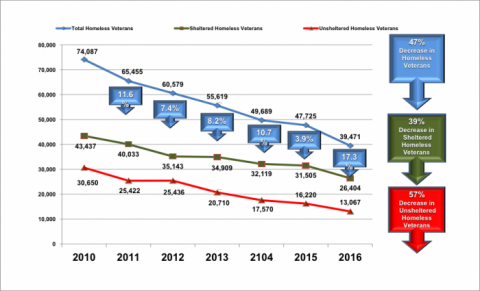- Home
- Agencies
- Department of Agriculture
- Department of Housing and Urban Development
- General Services Administration
- Department of Commerce
- Department of the Interior
- National Aeronautics and Space Administration
- Department of Defense
- Department of Justice
- National Science Foundation
- Department of Education
- Department of Labor
- Office of Personnel Management
- Department of Energy
- Department of State
- Small Business Administration
- Environmental Protection Agency
- Department of Transportation
- Social Security Administration
- Department of Health and Human Services
- Department of the Treasury
- U.S. Agency for International Development
- Department of Homeland Security
- Department of Veterans Affairs
- Goals
- Initiatives
- Programs
Ending Veterans Homelessness
What’s the issue?
The U.S. Department of Veterans Affairs (VA) took decisive action toward the federal goal of ending homelessness among Veterans. The Ending Veteran Homelessness initiative was intended to prevent Veterans and their families from entering homelessness and to assist those who are homeless in exiting as quickly as possible. VA’s “no wrong door” philosophy ensures that Veterans who are homeless and those at-risk for homelessness have timely access to appropriate housing and services. Any door a Veteran comes to - at a VA medical center, a VA regional office, or a community organization - leads to the personnel and programs to offer the Veteran assistance. Ending homelessness among Veterans will advance the mission of VA by ensuring that all Veterans and their families achieve housing stability and improved quality of life.
What was the intervention?
Effectively ending homelessness among Veterans requires rapid access to permanent housing, health care, employment, benefits, and other supportive services. VA and its federal partners work closely with community partners to meet current and new demands for Veterans experiencing or at risk of homelessness. Housing First and Rapid Re-housing are two of the many evidence-based approaches VA uses to end homelessness. The Housing First model follows the philosophy of providing permanent housing as quickly as possible to Veterans and Veteran families experiencing homelessness and then wrapping health care and other supportive services as needed around the Veteran to sustain housing and improve their quality of life. Rapid Re-housing is a set of strategies to help Veteran and Veteran families quickly move out of homelessness and into permanent housing. It provides crisis intervention services and typically involves housing search and landlord mediation assistance, short-term or flexible rental assistance, and case management services that support housing stability.
In order to achieve a synchronous, nationwide end to Veteran homelessness, the Homeless Program Office developed an operations management framework to drive operations at a national, network, and local level. Implemented in 2015, this framework provided a coordinated nationwide approach with local focus and was a strong contributing factor in meeting key performance goals in FY 2016.
How was performance management useful?
The operations management framework is comprised of integrated processes and tools engineered to achieve five key objectives: anticipating need, fully employing VA assets, performing strategically targeted operational improvements, allocating additional assets, and leverage community partnerships. The tools and outcomes associated with this framework are reviewed regularly on both a national and local level to address any emergent issues, disseminate proven practices and ensure that resources are optimally utilized to assist homeless and at-risk Veterans. Components of the platform include:
- Homeless Services Scorecard displays measures that provide transparency across the enterprise.
- Semi-annual Gap Analysis Tool estimates Veteran need for programs/services and identifies gaps in meeting those needs.
- Operating Plan Tool requires VA Medical Centers on a quarterly basis to identify strategies, goals, and objectives to respond to metrics that are falling short of the target.
- Web-based Operational Planning Hub provides decision support tools, data/programmatic support resources to help maximally leverage assets/community partners towards ending homelessness.
- Innovative Practices identifies and shares strong practices which improved performance and closed service gaps.
What was the impact?
VA, with the U.S. Department of Housing and Urban Development (HUD) and the United States Interagency Council on Homelessness (USICH), and in partnership with numerous public and private-sector entities nationwide have made significant progress toward the goal of ending Veteran homelessness. Overall, Veteran homelessness has declined by nearly 50 percent since 2010, the year that the Ending Veteran Homelessness initiative was initiated. According to the results of HUD’s 2016 Point-in-Time (PIT) Count, fewer than 40,000 Veterans were experiencing homelessness on a single night in January 2016. Of these just over 13,000 were unsheltered and on the street. This accounted for more than 17 percent decline in Veteran homelessness in the one year since the 2015 PIT Count—quadruple the rate of decline between 2014-2015. Progress to date, both nationally and at the community level, can be attributed to implementation of proven practices such as Housing First and the improved operational oversight augmented by the Operations Management Framework.
Data/Graph

|
According to HUD’s 2016 Point-in-Time (PIT) Count, fewer than 40,000 Veterans were experiencing homelessness on a single night in January 2016 and just over 13,000 were on the street. There was more than a 17 percent decline in Veteran homelessness in the one year since the 2015 PIT Count—quadruple the rate of decline between 2014-2015 and a 47 percent decrease since 2010. |




